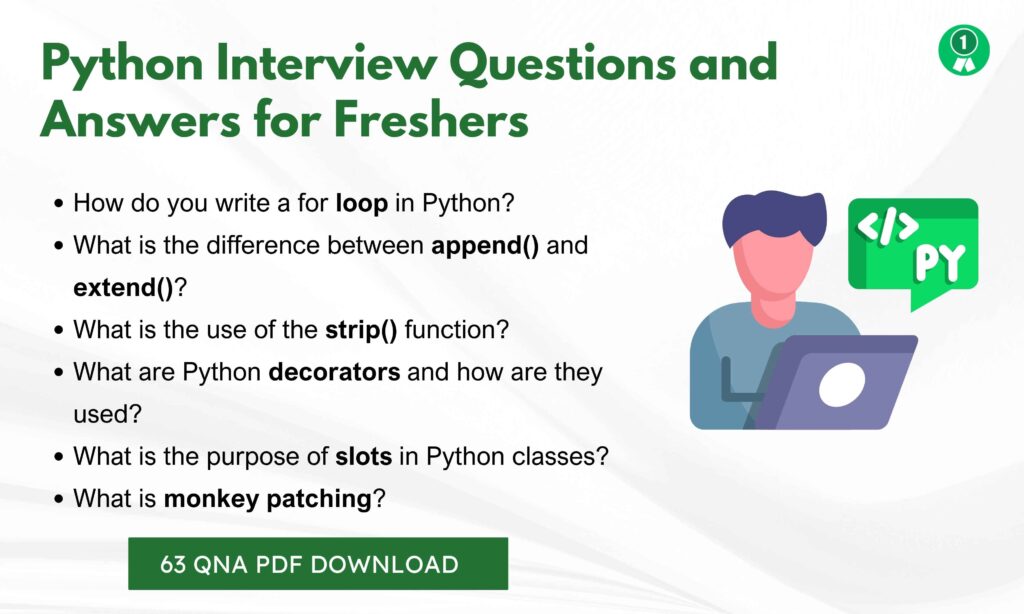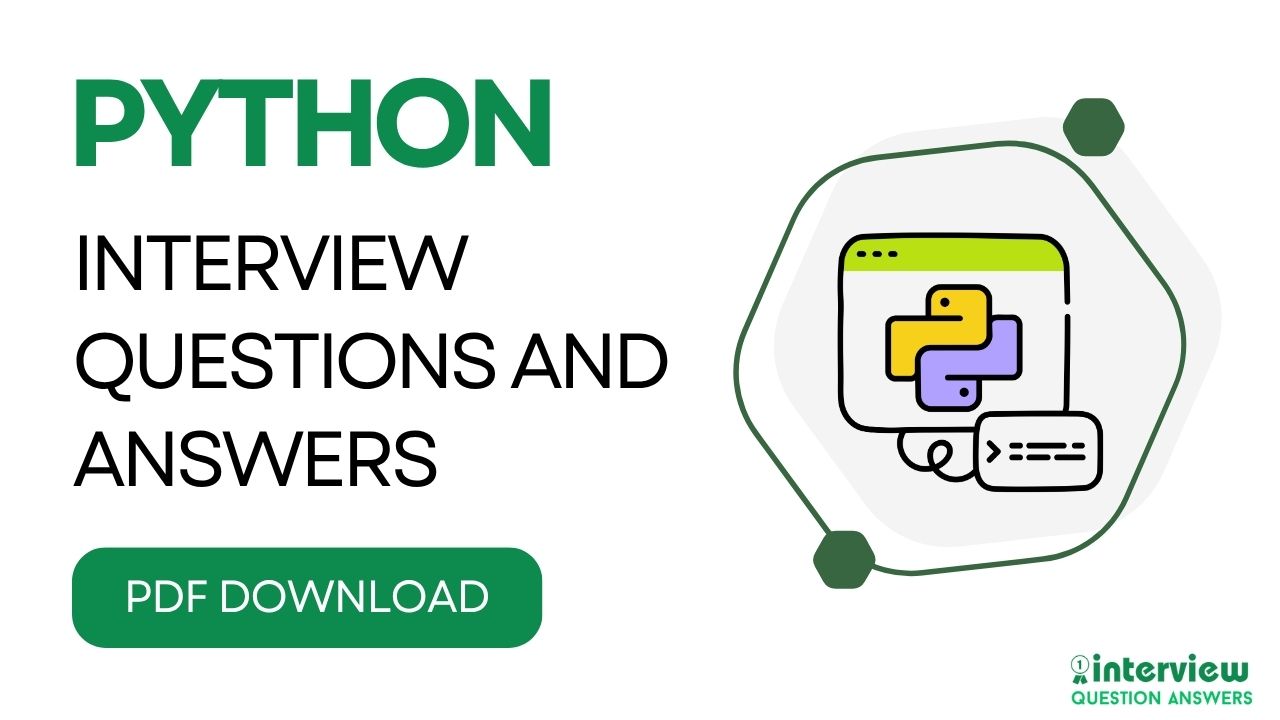Python has become essential in modern job markets, particularly in software development, data science, and automation roles. This versatile language handles web development, data analysis, machine learning, and scripting tasks efficiently.
Python developers need technical knowledge in object-oriented programming, data structures, libraries like pandas and NumPy, database integration, and framework expertise. Strong problem-solving skills and algorithmic thinking are equally important.
Interview preparation is crucial as it builds confidence and helps candidates demonstrate their Python proficiency effectively. Proper preparation enables developers to tackle coding challenges, explain concepts clearly, and showcase practical experience.
Here we share popular Python interview questions and answers covering fresher to experienced levels, including technical and real-life scenario-based questions. This comprehensive guide helps you prepare thoroughly for your next Python interview. We also provide a downloadable PDF for offline preparation convenience.
Table of Contents
Basic Python Interview Questions and Answers for Fresher
Here are Basic Python Interview Questions and Answers for Fresher. These questions are designed to help freshers prepare for real-world Python coding interviews.
Que 1. What are the key features of Python?
Answer:
| Feature | Description |
|---|---|
| Easy-to-read Syntax | Python code is clean and resembles plain English |
| Interpreted Language | Code is executed line by line without the need for compilation |
| Dynamically Typed | No need to declare variable types explicitly |
| Large Standard Library | Extensive built-in modules and functions for various tasks |
| Supports OOP & Functional Programming | Enables both object-oriented and functional coding styles |
Que 2. What is the difference between a list and a tuple?
Answer:
- List is mutable (can be changed)
- Tuple is immutable (cannot be changed)
Example:
my_list = [1, 2, 3]
my_tuple = (1, 2, 3)Que 3. How do you write comments in Python?
Answer:
Single-line comments use #.
Multi-line comments can use triple quotes.
# This is a comment
"""
This is a
multi-line comment
"""Que 4. How do you define a function in Python?
Answer:
Using the def keyword.
def greet(name):
return "Hello " + nameQue 5. What is the use of the len() function?
Answer:
It returns the number of elements in a sequence like list, tuple, or string.
len("Python") # Output: 6Que 6. What is a dictionary in Python?
Answer:
A dictionary is a collection of key-value pairs.
my_dict = {"name": "John", "age": 25}Que 7. What is the use of the type() function?
Answer:
It returns the data type of an object.
type(5) # Output: <class 'int'>
type("Hi") # Output: <class 'str'>Que 8. What is list comprehension?
Answer:
A concise way to create a list using a single line.
squares = [x**2 for x in range(5)]Que 9. How do you handle exceptions in Python?
Answer:
Using try and except blocks.
try:
print(1 / 0)
except ZeroDivisionError:
print("Cannot divide by zero")Que 10. What is the difference between is and ==?
Answer:
==checks if values are equalischecks if two variables point to the same object
Que 11. What is a module in Python?
Answer:
A file containing Python definitions and functions, which can be imported using the import keyword.
Que 12. How can you get user input in Python?
Answer:
Using the input() function.
name = input("Enter your name: ")Que 13. How do you write a for loop in Python?
Answer:
for i in range(5):
print(i)Que 14. What is the difference between append() and extend()?
Answer:
append()adds a single elementextend()adds multiple elements from another iterable
a = [1, 2]
a.append([3, 4]) # [1, 2, [3, 4]]
a.extend([5, 6]) # [1, 2, [3, 4], 5, 6]Que 15. What are the Boolean values in Python?
Answer:True and False, used in conditions and logical operations.
Que 16. How do you check if an element exists in a list?
Answer:
Using the in keyword.
if 5 in [1, 2, 3, 4, 5]:
print("Found")Que 17. What is the use of the strip() function?
Answer:
It removes leading and trailing whitespaces from a string.
" hello ".strip() # Output: "hello"Que 18. What is a set in Python?
Answer:
A collection of unique elements.
my_set = {1, 2, 3, 3} # Output: {1, 2, 3}Que 19. How do you concatenate two strings?
Answer:
Using the + operator.
"Hello" + " " + "World"Que 20. What is the output of bool([])?
Answer:False, because empty lists are considered false in a Boolean context.

Also Check: Python Interview Questions and Answers for Freshers
Advanced Python Interview Questions and Answers for Experienced
These questions gradually increase in complexity and focus on deeper Python concepts, tools, and practices.
Que 21. What are Python decorators and how are they used?
Answer:
A decorator is a function that modifies another function without changing its source code. Used for logging, authorization, caching, etc.
def my_decorator(func):
def wrapper():
print("Before function call")
func()
print("After function call")
return wrapper
@my_decorator
def greet():
print("Hello")
greet()Que 22. What is a generator in Python and how is it different from a normal function?
Answer:
Generators return iterators using yield instead of return. They produce values lazily, one at a time, which makes them memory-efficient.
def count_up_to(n):
i = 1
while i <= n:
yield i
i += 1Que 23. What is the Global Interpreter Lock (GIL) in Python?
Answer:
The GIL ensures only one thread executes Python bytecode at a time in CPython. This limits multi-threaded performance in CPU-bound tasks.
Que 24. What are context managers in Python?
Answer:
Context managers manage resource allocation using with statements (e.g., file handling). They implement __enter__ and __exit__.
with open("file.txt", "r") as f:
data = f.read()Que 25. How do you handle memory management in Python?
Answer:
Python uses reference counting and garbage collection for memory management. The gc module can manually interact with the garbage collector.
Que 26. What is the purpose of slots in Python classes?
Answer:__slots__ limits the attributes of instances and reduces memory overhead.
class MyClass:
__slots__ = ['name', 'age']Que 27. Explain metaclasses in Python.
Answer:
A metaclass controls the creation of classes. It is a class of a class, defined using type.
class Meta(type):
def __new__(cls, name, bases, dct):
print("Creating class:", name)
return super().__new__(cls, name, bases, dct)Que 28. What is monkey patching?
Answer:
Monkey patching means modifying or extending code at runtime, usually to replace methods or attributes.
import datetime
datetime.datetime.now = lambda: "2025-01-01"Que 29. What are Python’s magic methods?
Answer:
Also known as dunder methods, they include methods like __init__, __str__, __len__, __eq__, and define class behaviors.
Que 30. How do you use memoization in Python?
Answer:
By storing the results of expensive function calls using functools.lru_cache.
from functools import lru_cache
@lru_cache(maxsize=None)
def fib(n):
return n if n < 2 else fib(n-1) + fib(n-2)Que 31. How does Python’s property() function work?
Answer:
It turns class methods into managed attributes using @property decorator.
class Person:
def __init__(self, name):
self._name = name
@property
def name(self):
return self._nameQue 32. What is the difference between shallow and deep copy?
Answer:
Shallow copy copies references, deep copy duplicates objects recursively.
import copy
shallow = copy.copy(obj)
deep = copy.deepcopy(obj)Que 33. How do you create a custom iterator in Python?
Answer:
By defining __iter__() and __next__() methods in a class.
class Counter:
def __init__(self, max):
self.max = max
self.n = 0
def __iter__(self):
return self
def __next__(self):
if self.n < self.max:
self.n += 1
return self.n
raise StopIterationQue 34. What are Python coroutines and how do they differ from generators?
Answer:
Coroutines are like generators but support bidirectional communication with send() and await.
def coroutine():
while True:
x = yield
print(f"Received: {x}")Que 35. How can you make your Python code thread-safe?
Answer:
Use locks from the threading module to protect shared resources.
import threading
lock = threading.Lock()
def safe_increment():
with lock:
# modify shared variable
passAlso Check: Top Python Interview Questions for Experienced
Python Interview Questions and Answers for Data Analyst
Here are python questions focused for data analyst roles.
Que 36. How do you read a CSV file using Python?
Answer:
You can read a CSV file using the Pandas library.
import pandas as pd
df = pd.read_csv("data.csv")Que 37. How do you handle missing data in a DataFrame?
Answer:
You can use dropna() to remove missing values or fillna() to replace them.
df.dropna() # Drop rows with missing values
df.fillna(0) # Replace missing values with 0Que 38. How do you filter rows based on a condition?
Answer:
Use boolean indexing.
filtered_df = df[df["sales"] > 1000]Que 39. What does “Groupby()” do in pandas?
Answer:groupby() groups rows based on one or more columns and allows aggregation.
df.groupby("region")["sales"].sum()Que 40. How do you merge two DataFrames?
Answer:
Use the merge() function in pandas.
merged_df = pd.merge(df1, df2, on="customer_id", how="inner")Que 41. How do you create a pivot table in pandas?
Answer:
Use pivot_table() to summarize data.
df.pivot_table(values="sales", index="region", columns="month", aggfunc="sum")Que 42. How do you calculate correlation between variables?
Answer:
Use the corr() method to calculate pairwise correlations.
df.corr()Que 43. How do you find the top 5 rows with the highest values in a column?
Answer:
Use nlargest().
df.nlargest(5, "sales")Que 44. How do you rename columns in a DataFrame?
Answer:
Use rename() method with a dictionary of old and new names.
df.rename(columns={"old_name": "new_name"}, inplace=True)Que 45. How do you visualize data in Python?
Answer:
Use libraries like matplotlib or seaborn.
import seaborn as sns
sns.barplot(x="region", y="sales", data=df)Need more? you can check here: Data Analyst Interview Questions and Answers
Python Interview Questions and Answers for Data Engineer
These questions cover essential Python skills required in data engineering roles, progressing from basic to slightly advanced.
Que 46. How do you read and write data from a text file in Python?
Answer:
with open("file.txt", "r") as f:
data = f.read()
with open("file.txt", "w") as f:
f.write("New data")Que 47. How do you connect Python to a relational database?
Answer:
You can use libraries like sqlite3, psycopg2, or SQLAlchemy.
import sqlite3
conn = sqlite3.connect("example.db")
cursor = conn.cursor()
cursor.execute("SELECT * FROM users")Que 48. How do you handle large datasets in Python?
Answer:
Use chunking with pandas, or scalable libraries like Dask for parallel processing.
for chunk in pd.read_csv("large_file.csv", chunksize=10000):
process(chunk)Que 49. How do you schedule data pipelines in Python?
Answer:
You can use tools like Airflow, Luigi, or system tools like cron to run Python scripts on schedule.
Que 50. What is the use of the “os” module in file operations?
Answer:os helps in interacting with the operating system for file and directory handling.
import os
os.listdir(".")
os.remove("data.txt")
Que 51. How do you use environment variables in Python scripts?
Answer:
Use the os.environ dictionary to access environment variables.
import os
db_user = os.environ.get("DB_USER")Que 52. How do you serialize and deserialize data in Python?
Answer:
Use the pickle or json modules for serialization.
import json
data = {"name": "John"}
with open("data.json", "w") as f:
json.dump(data, f)Que 53. How do you process streaming data in Python?
Answer:
Use frameworks like Apache Kafka with confluent-kafka-python, or PySpark Streaming.
Que 54. What is the purpose of the “Multiprocessing” module?
Answer:
It allows you to run multiple processes in parallel to utilize multiple CPU cores.
from multiprocessing import Pool
def square(n):
return n * n
with Pool(4) as p:
results = p.map(square, [1, 2, 3, 4])Que 55. How do you interact with AWS S3 in Python?
Answer:
Use the boto3 library to upload, download, or list objects in S3.
import boto3
s3 = boto3.client("s3")
s3.download_file("my-bucket", "data.csv", "data.csv")Need more? you can check here: Data Engineer Interview Questions and Answers
Most Common Python Interview Questions
Que 56. What is the difference between is and == in Python?
Answer:
==checks if two values are equal.ischecks if two variables point to the same object in memory.
a = [1, 2]
b = [1, 2]
a == b # True
a is b # FalseQue 57. What is the difference between append() and extend() in lists?
Answer:
append()adds a single item to the list.extend()adds elements from another iterable.
lst = [1, 2]
lst.append([3, 4]) # [1, 2, [3, 4]]
lst.extend([5, 6]) # [1, 2, [3, 4], 5, 6]Que 58. What is the use of zip() in Python?
Answer:zip() combines multiple iterables element-wise into tuples.
a = [1, 2]
b = ['a', 'b']
list(zip(a, b)) # [(1, 'a'), (2, 'b')]Que 59. How do you reverse a list or a string in Python?
Answer:
Use slicing or built-in functions.
lst = [1, 2, 3]
lst[::-1] # [3, 2, 1]
s = "Python"
s[::-1] # "nohtyP"Que 60. What is the difference between mutable and immutable types?
Answer:
- Mutable objects can be changed (like list, dict).
- Immutable objects cannot be changed (like int, str, tuple).
Que 61. What are Python’s lambda functions?
Answer:
A lambda function is an anonymous one-line function.
square = lambda x: x * x
square(4) # 16Que 62. What is the difference between deepcopy() and copy()?
Answer:
copy()creates a shallow copy (nested objects are still shared).deepcopy()creates a full independent copy.
import copy
shallow = copy.copy(obj)
deep = copy.deepcopy(obj)Que 63. What is the use of enumerate() in Python?
Answer:enumerate() returns both the index and value when looping through a list.
for index, value in enumerate(['a', 'b', 'c']):
print(index, value)Also Read: Python OOPs Interview Questions and Answers
Que 64. What is the purpose of the slots declaration in Python classes?
Answer:
The __slots__ declaration is used to explicitly declare data members and avoid the creation of __dict__ and __weakref__ for each instance. This helps:
- Reduce memory usage, especially for large numbers of objects.
- Speed up attribute access.
- Prevent accidental addition of new attributes.
It’s mainly used in performance-critical or memory-constrained applications.
Que 65. How do you implement the Singleton pattern in Python?
Answer:
In Python, Singleton ensures a class has only one instance. You can implement it using the __new__ method:
class Singleton:
_instance = None
def __new__(cls):
if cls._instance is None:
cls._instance = super(Singleton, cls).__new__(cls)
return cls._instance
Alternatively, you can use a metaclass to enforce singleton behavior across classes.
Que 66. What are weak references in Python and when would you use them?
Answer:
Weak references allow an object to be referenced without increasing its reference count. When no strong references remain, the object is garbage collected.
They’re useful in:
- Caching mechanisms
- Avoiding memory leaks
- Implementing observers or callback registries
You can use weakref.ref() or WeakValueDictionary from the weakref module.
Que 67. How does Python’s garbage collector handle cyclic references?
Answer:
Python’s garbage collector has three generations. While reference counting handles most memory, cyclic references are handled by the gc module, which uses:
- A generational garbage collection algorithm
- Cycle detection to collect unreachable objects
Developers can manually control it using gc.collect() or disable it in performance-sensitive scenarios.
Que 68. What are metaclasses in Python?
Answer:
Metaclasses define the behavior and construction of classes. In Python, type is the default metaclass. By customizing it, you can:
- Enforce coding standards
- Auto-modify class attributes or methods
- Implement custom registries
They are powerful, but should be used with caution due to complexity.
Que 69. How can you implement method chaining in Python?
Answer:
Method chaining allows multiple method calls in one line by returning self from each method:
class Builder:
def step1(self):
# logic
return self
def step2(self):
# logic
return selfThis pattern improves code fluency and readability, especially in builder-like structures.
Que 70. What are descriptors and how do they work in Python?
Answer:
Descriptors are Python objects that implement any of the methods: __get__, __set__, or __delete__. They’re used to manage attribute access.
Common use cases:
- Implementing properties
- Reusable validation
- Lazy evaluation
They are foundational to how @property works internally.
Que 71. How do you prevent race conditions in Python multithreading?
Answer:
To prevent race conditions, you can use synchronization primitives from the threading module:
Lockfor critical sectionsRLockwhen the same thread acquires the lock multiple timesSemaphoreorEventfor more advanced control
Always ensure locks are released using with statements.
Que 72. How can you implement caching in Python applications?
Answer:
Common caching techniques in Python:
- Use
functools.lru_cache()for function result caching - Use
cachetoolsfor TTL or LFU caching - Custom cache classes with dictionary + expiry handling
Caching improves performance, especially for I/O-bound or CPU-heavy tasks.
Que 73. What is the difference between multiprocessing and multithreading in Python?
Answer:
| Feature | Multithreading | Multiprocessing |
|---|---|---|
| CPU Utilization | Limited by GIL | True parallelism |
| Use Case | I/O-bound tasks | CPU-bound tasks |
| Overhead | Low | High |
| Modules | threading | multiprocessing |
Multiprocessing bypasses the GIL by using separate processes, ideal for CPU-intensive operations.
Que 74. How do you handle memory leaks in long-running Python applications?
Answer:
Strategies include:
- Use
tracemallocto monitor memory allocation - Detect reference cycles with
gc.get_objects()andgc.collect() - Avoid global variables holding large data
- Prefer generators over large in-memory lists
Profiling tools like objgraph help identify leaks visually.
Que 75. How do you build and publish a Python package?
Answer:
Steps:
- Create a
setup.pyorpyproject.toml - Add a proper directory structure and
__init__.py - Use
setuptoolsorpoetry - Build with
python setup.py sdist bdist_wheel - Publish using
twine upload dist/*
Follow semantic versioning and include README.md and license.
Also Check: Pandas and NumPy Interview Questions and Answers
Que 76. How do you optimize performance in Python loops?
Answer:
- Use list comprehensions over manual loops
- Avoid repeated attribute lookups or function calls
- Use
join()instead of string concatenation - Use built-in functions like
map(),filter() - Leverage NumPy or Cython for numerical work
Profiling tools like cProfile help identify bottlenecks.
Que 77. How do you implement a custom context manager?
Answer:
You can use a class with __enter__ and __exit__ methods or the @contextmanager decorator:
from contextlib import contextmanager
@contextmanager
def managed_resource():
setup()
try:
yield
finally:
cleanup()Custom context managers are useful for resource handling like file access, locks, or connections.
Que 78. How do you use abstract base classes in Python?
Answer:
Abstract base classes (ABCs) are defined using the abc module:
from abc import ABC, abstractmethod
class Shape(ABC):
@abstractmethod
def area(self):
pass
They enforce a contract for subclasses and are useful for designing large systems with interface-like behavior.
Que 79. How does Python’s asyncio event loop work?
Answer:
The asyncio event loop schedules and executes asynchronous tasks using await. It’s single-threaded but enables high-concurrency for I/O-bound tasks.
Key elements:
async defdefines coroutineawaityields control to event looploop.run_until_complete()runs a coroutine
Que 80. How do you parse and validate JSON data in Python?
Answer:
Use the json module for parsing:
import json
data = json.loads(json_str)To validate structure, use:
pydanticjsonschema- Custom validation logic
Always handle parsing exceptions with try-except.
Que 81. What is duck typing and how is it applied in Python?
Answer:
Duck typing is Python’s dynamic typing system: “If it walks like a duck and quacks like a duck…”
This means objects are not checked for types, but for behaviors. Example: any object with __len__() is valid for len().
Que 82. What are the different memory views in Python and when should you use them?
Answer:
The memoryview object allows you to manipulate binary data without copying it. Useful for:
- Large buffers (e.g., images, I/O streams)
- Interfacing with C extensions
- Avoiding overhead of slicing large
bytesobjects
Que 83. How do you ensure immutability in custom classes?
Answer:
Use:
@dataclass(frozen=True)- Define
__setattr__to raise errors - Use tuples or frozensets for attributes
Immutable objects are hashable and thread-safe by default.
Que 84. What are Python wheels and why are they important?
Answer:
Wheels (.whl) are built distributions that eliminate the need to compile source during installation. They:
- Speed up package installations
- Support binary dependencies
- Are used with
pip install package.whl
They’re the standard for Python packaging.
Que 85. What is monkey patching in Python and what are its risks?
Answer:
Monkey patching means dynamically changing a class or module at runtime. While useful for testing/mocking, it can:
- Lead to hard-to-find bugs
- Break API behavior unexpectedly
Use it cautiously and prefer dependency injection when possible.
Que 86. How do you create a plugin system in Python?
Answer:
Use:
importlibfor dynamic imports- Define a plugin interface/base class
- Load plugins from modules or folders
This pattern is often seen in extensible apps, IDEs, and frameworks.
Que 87. How do you implement retry logic with exponential backoff?
Answer:
You can use retrying, tenacity, or custom logic:
for attempt in range(5):
try:
call_api()
break
except Exception:
time.sleep(2 ** attempt)This helps in dealing with flaky I/O operations like API calls.
Que 88. How do you test asynchronous code in Python?
Answer:
Use pytest with pytest-asyncio:
@pytest.mark.asyncio
async def test_async_function():
result = await my_async_func()
assert result == expectedYou can also use asyncio.run() and event loop mocks.
Que 89. What is the role of getattr and getattribute?
Answer:
__getattr__: Called when an attribute is not found__getattribute__: Called for every attribute access
They’re useful for delegation, proxies, or implementing dynamic attributes.
Que 90. How does Python handle circular imports?
Answer:
Python raises ImportError when modules depend on each other during initialization. To fix:
- Use local imports
- Restructure code
- Delay imports using
importlib
Circular imports are often a sign of poor modularization.
Also Check: Full Stack Developer Interview Questions
Que 91. How do you use Python’s typing module to write type-safe code?
Answer:
The typing module enables static type hints, improving code readability and tooling support. Common annotations include:
from typing import List, Dict, Tuple
def process_data(data: List[str]) -> Dict[str, int]:
...
You can also use Optional, Union, Callable, Literal, and custom TypedDict to model complex structures. Tools like mypy help validate type consistency.
Que 92. How do you create and manage virtual environments in Python?
Answer:
Virtual environments isolate dependencies between projects. Use:
python -m venv env_namesource env_name/bin/activate(Unix) orenv_name\Scripts\activate(Windows)- Install packages with
pip install - Deactivate with
deactivate
This prevents dependency conflicts and is essential for production-grade Python development.
Que 93. How do you profile and debug Python applications?
Answer:
To profile performance:
- Use
cProfilefor function-level stats - Use
line_profilerfor line-by-line analysis - Use
memory_profilerfor memory usage
For debugging:
- Use
pdb(Python debugger) - IDEs like VS Code and PyCharm offer breakpoints and watch windows
- Logging (
loggingmodule) is preferred over print statements
Que 94. How do you implement custom exceptions in Python?
Answer:
Custom exceptions enhance clarity and control in error handling:
class InvalidInputError(Exception):
def __init__(self, message):
super().__init__(message)Use them to handle domain-specific errors, improve debugging, and enforce business logic in clean code.
Que 95. How do you ensure security when handling file uploads in Python web applications?
Answer:
To securely handle file uploads:
- Use
secure_filename()fromwerkzeug.utilsor sanitize filenames manually - Limit file size via server-side validation
- Restrict allowed MIME types
- Store files outside the public directory
- Scan uploaded files for malware if needed
Frameworks like Flask and Django offer built-in helpers for file upload handling.
Que 96. How do you build REST APIs using Python?
Answer:
Use frameworks like:
- Flask: Lightweight, good for microservices
- FastAPI: Modern, async-ready, with type hints
- Django REST Framework (DRF): Powerful and scalable for large apps
Key concepts include routing, serialization, request parsing, and response formatting. Tools like Postman help test APIs.
Also Check: Rest API Interview Questions
Que 97. How do you manage asynchronous tasks with Celery in Python?
Answer:
Celery is a distributed task queue used for:
- Sending emails
- Processing images
- Scheduled jobs
Setup includes:
- Broker (RabbitMQ or Redis)
@app.taskdecorator for async functions- Worker process to run tasks
- Beat scheduler for periodic jobs
Celery integrates well with Flask, Django, and FastAPI.
Que 98. What are Python wheels and how do they differ from source distributions?
Answer:
Wheels (.whl) are pre-built binary distributions. Compared to source distributions (.tar.gz):
| Feature | Wheel (.whl) | Source (.tar.gz) |
|---|---|---|
| Compilation needed | No | Yes |
| Installation speed | Fast | Slower |
| Platform specific | Yes (for C extensions) | No |
Use pip install package.whl for fast installs and deployment.
Que 99. How can you safely execute dynamic Python code?
Answer:
To safely run dynamic code:
- Avoid
eval()orexec()unless absolutely necessary - Use
ast.literal_eval()for safe evaluation of expressions - For full sandboxing, use subprocesses, containers, or third-party libraries like
RestrictedPython
Dynamic execution should be sandboxed and validated to prevent security vulnerabilities.
Que 100. How do you manage configuration in Python applications?
Answer:
Use layered config management:
.envfiles withdotenvto manage environment variables- Use
configparser,yaml, orjsonfiles for structured config - Access using
os.environ.get("KEY")or libraries likedynaconf
Separate config from code, support multiple environments (dev, staging, prod), and avoid hardcoding secrets.
Also Check: Automation Testing Interview Questions and Answers
Python Interview Questions and Answers PDF
We are adding this pdf file of python questions so you can prepare anytime easily.
FAQs: Python Interview Questions
What does a Python job role typically involve?
Python roles vary by industry but commonly include writing clean and efficient code for automation, data analysis, web development, machine learning, or backend systems. Depending on the job title (e.g., Python Developer, Data Analyst, ML Engineer), tasks may involve scripting, building APIs, working with databases, or integrating with third-party tools.
What are the biggest challenges faced during a Python interview?
Candidates often struggle with writing optimized code under time pressure, solving data structure and algorithm problems, and demonstrating real-world use of libraries like pandas, NumPy, or Django. Interviews may also test system design skills, SQL knowledge, and debugging abilities.
What skills are most important to crack a Python interview?
Key skills include:
Proficiency in core Python concepts (data types, OOP, functions)
Knowledge of libraries relevant to the role (e.g., pandas for data roles, Flask/Django for web)
Understanding of software development practices (Git, testing, REST APIs)
Problem-solving with algorithms and data structures
Familiarity with databases and cloud platforms (like AWS)
What is the average salary for Python developers in the USA?
As of 2025, the average salary for a Python Developer in the USA ranges from $90,000 to $135,000 per year, depending on experience and location. Entry-level positions start around $75,000, while senior roles can exceed $150,000, especially in tech hubs like San Francisco, Seattle, and New York.
Which top companies actively hire Python professionals?
Major companies hiring for Python roles include: Google, Meta (Facebook), Amazon, Microsoft, Netflix, IBM, Uber, Airbnb, Spotify, JPMorgan Chase. These roles range across software engineering, data science, AI/ML, and backend development.
Conclusion
We have shared various types of Python interview questions and answers, covering roles from freshers to experienced professionals. A PDF download is also available, allowing you to prepare offline easily.







